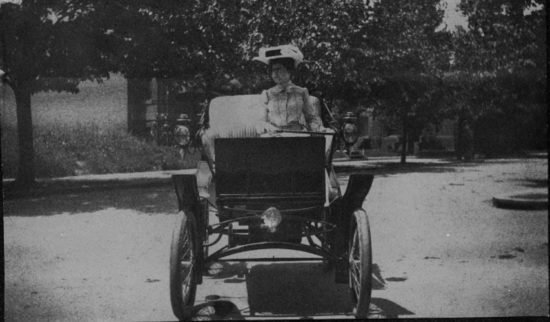38% Of American Cars Were Electric In 1900
 |
| Wilson Electric Car |
By Jake Richardson/Cleantecnica
In our modern era, we may assume that electric cars are new technology. The Chevy Bolt, Nissan LEAF, and all Tesla vehicles are certainly cutting-edge automobiles, right? But there was a period in America a long time ago when about 30% of all cars were electric. (Today, only about 1% of the fleet runs on electricity.) Electric cars were first created in the early to mid-1800s.
In 1898, Dr. Ferdinand Porsche, when 23 years old, built his first car, and it was the Lohner Electric Chaise. Also in 1898, Count Gaston de Chasseloup-Laubat of Paris set a world speed record in a car, which happened to be in his electric Jeantaud. The speed record was 39.245 mph (62.8 km/h), but that was crushed a few days later by another electric car that went 65.79 mph (105.88 km/h).
By 1900, in the United States, 38% of US automobiles, 33,842 cars, were powered by electricity (40% were powered by steam, and 22% by gasoline). This information might sound like some crackpot Internet hoax, but if you look at the sources, you can easily see they are credible. The US Dept. of Energy’s page on the history of the electric car states, “By 1900, electric cars were at their heyday, accounting for around a third of all vehicles on the road. During the next 10 years, they continued to show strong sales." By 1912, there were 38,843 on US roads.
Horses, steam-powered cars, and gas-powered cars were also available at that time. Electric cars were appealing to some women who preferred the quieter rides and the fact that electric cars started very easily — there was no crank to push and pull like gasmobiles of the time had. Additionally, there was no smoke, there were no smelly fumes, and there was no gassing up. A New York Times article from about 1911 described this preference.
In around 1914, Henry Ford and Thomas Edison were collaborating on an electric vehicle. “Within a year, I hope, we shall begin the manufacture of an electric automobile. I don’t like to talk about things which are a year ahead, but I am willing to tell you something of my plans. The fact is that Mr. Edison and I have been working for some years on an electric automobile which would be cheap and practicable."
Unfortunately, if not tragically, this project fell by the wayside. One can only imagine what might have happened if Henry Ford had begun producing some simple, affordable electric cars along with the gasmobiles his company turned out in huge numbers. One of his experimental EVs actually used a Model T frame.
During this period, Edison was very enthusiastic about the potential of electric vehicles, “I believe that ultimately the electric motor will be universally used for trucking in all large cities, and that the electric automobile will be the family carriage of the future. All trucking must come to electricity. I am convinced that it will not be long before all the trucking in New York City will be electric."
Henry Ford’s wife, Clara, actually preferred an EV over a Ford gasmobile. Her preferred brand seemed to be Detroit Electric.
 |
| The Frichtle |
The 1914 electric Frichtle reportedly had a range of about 60–100 miles but also cost several times more than a Model T. It’s creator, Oliver Frichtle, drove one of his vehicles more than halfway across the country in one trip to prove that his technology was vigorous. “Fritchle drove the eighteen hundred miles between Lincoln and New York in twenty-nine days averaging close to ninety miles per battery charge across extremes in weather, terrain, and road conditions. The time included about twenty-one days of driving and eight for rest, sightseeing, and visits."
The trip covered muddy, rut-filled surfaces that were at times very difficult to drive on — ones that we might consider today as something similar to off-roading.
Frichtle’s car company was located in Denver and the “unsinkable" Molly Brown was both an owner/driver and a fan.
Here are just some of the electric cars that were available in the early 1900s.
A 1901 Baker Electric
A 1909 Babcock — a New York-based car manufacturer produced it.
President Woodrow Wilson had a Milburn Electric for riding around in Washington, D.C.
Milburn Electric
His wife, Edith Bolling Galt Wilson, liked electric cars too. According to the Library of Congress, she was the first woman to drive an electric car in the District of Columbia, a trip that took place in 1904. At that time, she was married to someone else, though. “The document indicates that Mrs. Galt was authorized to operate a vehicle of the ‘electric type.’ The cost of the vehicle amounted to $1600 in 1904 (equivalent to about $44,000 in 2017). This particular model was marketed to women and advertised as a carriage for ‘light pleasure service,’ ‘park riding,’ and ‘social functions.’ It would reach speeds of up to thirteen miles per hour and run for forty miles on a single charge."
Mamie Eisenhower’s mother had one of these Rauch and Lang electrics:
Eventually, electric cars fell out of favor because gasmobiles cost less, the electric starter was invented, and gas and oil became cheap and plentiful, so affordable long-distance travel was made possible.
Today, electric vehicles are making quite a resurgence and appear poised to eventually surpass gasmobiles for a variety of compelling reasons, eventually.
Videos (recommended viewing):
